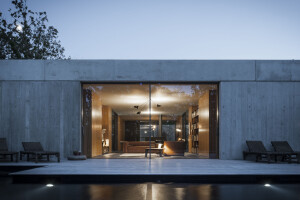This building is an exceptionally sustainable and extremely energy efficient town hall fitted into the landscape of the Achterhoek
Five small local authorities in the Achterhoek (Gelderland) merged and became a single local authority with the name Bronckhorst on 1 January 2005. This combines forty villages and hamlets to form one of the largest rural local authorities in the Netherlands with almost 40,000 residents. Atelier PRO designed a town hall for this local authority. This building convincingly and elegantly symbolises the new administrative unit. The surroundings of the unique Gelderland landscape inspired the architectural crystallisation of the form.
The landscape of the Achterhoek is slightly sloping. Brooks run into the Oude and Gelderse IJssel. The views are framed by groups of trees and hedges. The agrarian plots are angular and proceed in series of straight lines at angles to each another. The design of the town hall is a subtle reaction to this physical setting. The civil servants work here, the council takes its decisions here, and the citizens are served here – all in the clearest and most transparent possible way!
Two office wings project slightly outwards and have been placed next to each other on a wedge-shaped site between the Elderinkweg and a brook near the Rondweg that goes past the village of Hengelo. The wings are of different heights, and the highest has a gently sloping roof. Openings have been introduced in both inner sides at the middle of the wings: a high one for the council chamber, a low one for the public counters. Passers-by on the Rondweg see the large window of the council chamber, while vice versa the councillors have a view of the church spire of Hengelo, groups of trees and farms. The central corridor has skylights that allow bright light to illuminate the walls of a yellow-white brick and the wooden floor.
Bronckhorst has been given a town hall with an extremely low energy consumption. Applying the principles of passive building has made it possible to achieve an EPQ of 0.36 with this design. This means an energy consumption of only 36 per cent as compared to the norm laid down in the building regulations. As far as we know, this has never before been achieved in the Netherlands. The principles of passive building were applied with common sense. The ventilation is guided by CO2-monitoring and never drops below one-third of the minimum. The building has the highest possible Green Calc A+ Label. The shutters around the building are an eloquent example of intelligent exploitation of the principles of passive building. They are intended to keep an excess of solar warmth outside so that the building is not overheated in the daytime. An innovative feature is that they can be closed at night or when no movement of people is detected, to retain the warmth inside the building. The 280 insulating shutters were decorated with a relief by the artist Jaap Drupsteen. For the forty villages and hamlets, Bronckhorst Town Hall has become a calm, reticent place that occupies a worthy position in the scenic landscape of the Achterhoek.
Interior Atelier PRO envisaged a symbiotic relation between the interior and the building (and its surroundings). These scale levels must reinforce one another. A building is not an introverted object in the landscape or the city, and an interior is not a sauce that is poured over the building afterwards. The interior therefore also exudes the atmosphere of the building and the surroundings. The materials, colours, lighting, and view of the landscape from the interior (the interaction between indoors and outdoors) are manipulated in a subtle way to achieve this cohesion in mood and character.
Working process: The principal was the steering committee, consisting of a project manager, the councillor responsible, and a few top-level civil servants from the local authority. The user groups were represented for each domain/department by so-called ambassadors. An intake talk was held in each department to obtain a picture of the demands that did not appear in the programme of requirements. These ambassadors concentrated on the functional division, atmosphere, colours and ambience of the interior. The design was presented to the users at every stage.
The cooperation between the project manager and the architect was very intensive, particularly because the interior had to be completed within a extremely short period. Atelier PRO was the architect of both the building and the interior. There was thus intensive internal contact between the architects who concentrated on the building and the interior architects too. The feeling between the individuals and the informal contact played an important role in this process.
Support from the staff was mainly obtained by openness and listening to them seriously. This was done in intake talks, presentations at each stage, and the discussions with the ambassadors.
‘Het nieuwe werken’, the new way of working, is a theme that receives a lot of attention. The staff do not have a permanent desk, and the desks are left clean every evening. The town hall uses as little paper as possible. Room has thus literally been created for flexi-workers and part-time workers, enabling a sustainable and efficient use of the space. The quality and way of working are focal points in ‘Het nieuwe werken’. The work areas have different characters: there are areas where work requiring concentration can be done, areas for working with others, and administrative work areas. These three kinds of work areas raise specific demands: concentration, communication and administration respectively. Furthermore there is the informal area where staff can lounge, drink coffee, hold informal conversations, and spread the departmental news and perhaps gossip. This is where you will find the birth announcements, the postcards with the white beaches of Myanmar, and the trophy that the department won in the volleyball tournament. It is the place that makes work pleasant and gives a department the feeling of belonging together, a place that compensates the feeling of uprootedness that New Works entails.































